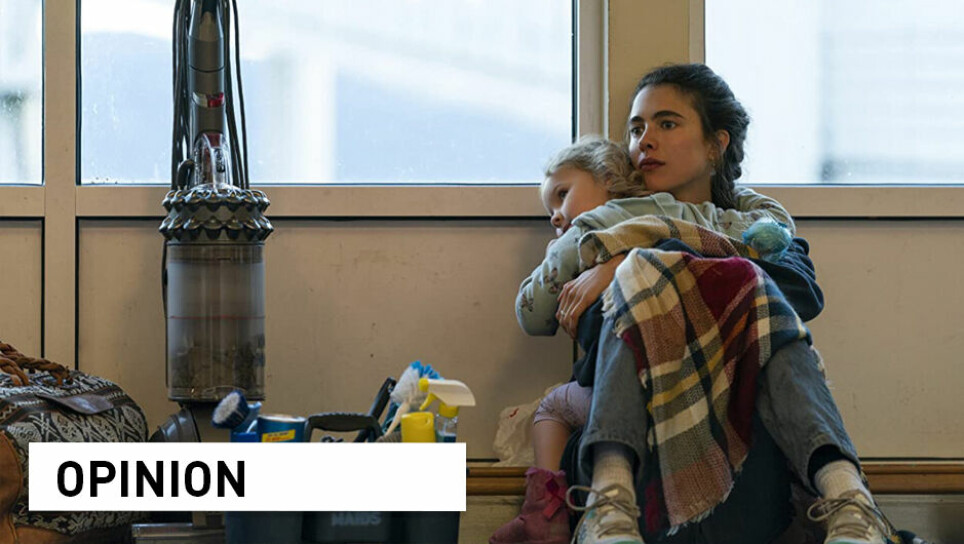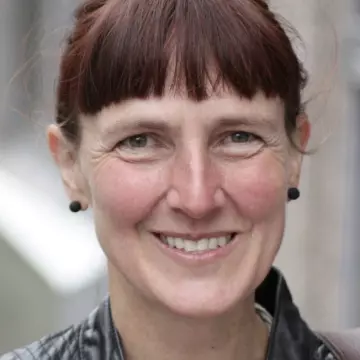Opinion:

The violence continues, even though the mother leaves the father. Are politics of gender equality to blame?
OPINION: Having to organise contact between the children and their father may result in continued exposure to violence for mothers – even after they leave a violent partner.
In the Netflix series Maid, we follow the protagonist Alex as she extricates herself from the relationship with her boyfriend, who is violent towards her. The series has received glowing reviews, both for the way it depicts the violence and for painting a nuanced picture of the violent boyfriend. He is not portrayed as a monster, but as someone who is struggling with his own childhood baggage.
Extreme stress and little support
As a researcher who has interviewed mothers who have left violent partners, what stands out in particular are the challenges facing Alex and her capacity to take action.
It requires an almost superhuman effort on Alex’s part to get away from the man and the violence, while remaining a good mother to her three-year-old daughter Maddy, manoeuvring within an insecure labour market and inadequate welfare system – and looking out for a mentally ill mother.
Seen through Norwegian eyes, the deficiencies in the US welfare system and labour market are striking, yet much is recognisable all the same. The mothers I have interviewed also find themselves in extremely challenging situations. They must care for their children under often extreme conditions, and encounter little understanding and support from those around them, including the services that are supposed to help them.
Leaving is not that simple
Although the series presents a vivid picture of the huge challenges Alex faces as a mother who is subject to violence and coercive control, I think the scriptwriters have made things a bit too easy for themselves.
How many abused mothers experience what Alex does - namely that their violent ex-partner has sufficient self-awareness to drop the court case and put the interests of the child before their own? Eventually, Alex does get away and takes her child to another part of the country, thereby saving both herself and the child from further violence.
The violence continues
For most abused mothers in Norway today, that would not be a realistic possibility.
Breaking away from a violent partner who is also the father of shared children is challenging and does not always lead to an escape from the violence. On the contrary, the mothers must often continue cooperating on child arrangements with a father who has been violent towards them.
For some, child arrangements will be an arena for continued violence. It can even be worse than before the breakup.
Some of the mothers I have interviewed found that the violence continues in meetings with the support services and through parental cooperation. They are verbally abused and threatened by their former partners in meetings with the support services.
They tell of stalking, control and financial abuse after the breakup. Some are subjected to sexual abuse when fathers pick up or drop off the children. Some of the mothers are far more frightened after the breakup, and fear what their ex-partners might do to them or the children.
Violent husbands are bad fathers
Concern for the children during time spent with their father and feeling powerless to protect them also puts a huge strain on mothers. Fear that the children will have to visit, and therefore be alone with, a father who the mother feels to be unsuitable can also prevent her from breaking away.
This fear is often not unwarranted. Research into partner-abusive fathers’ parenting finds that these fathers have poorer than average parenting skills. They demonstrate little ability to take the child’s perspective and are authoritarian, angry, unreasonable, and harsh (i.e. violent). Or they are the opposite: disengaged and indifferent.
Their parental practices are therefore a fair distance from what is expected of parents in Norway today. Nevertheless, most fathers – including those who have been violent towards the children’s mothers – have contact with their children after a breakup.
Burden of worry
Many mothers find they are pressured into agreeing to contact and sending the children to their fathers, despite fearing for the children’s health and safety.
One of the mothers expressed it like this:
“I’ve thought a lot about this; how bad does a person have to be? Before the children should not be with that person?”
In this respect, too, reality is rather worse than the TV series.
In the series, three-year-old Maddy remains apparently unaffected by the violence. Several of the mothers I have interviewed tell of children who are struggling and are affected by the violence both before and after the breakup.
Some tell of children who return from visits with a rib fracture, others of children who become sullen and taciturn, or who respond angrily and act out at kindergarten or in school.
Several had not received any help or found that it took many years before the children received the help they had asked for. The mothers must put in a lot of extra work, both to access help from the support services and to help the children to process their experiences. These damage-repair efforts and burden of worry come on top of day-to-day parenting and responsibility for managing everyday life at home and at work. This is a demanding enough task for most families with two functioning parents.
Modern fathers and traditional mothers
Why is there apparently so little understanding for abused mothers? One explanation could lie in Norway’s family and gender equality policies.
Shared parenting is the very foundation of the country's equality policy, and fathers have become the beacons of hope about modern parenthood and the gender equal family. Father involvement is also what is thought to liberate women, so that they can participate fully in society and the labour market. Fathers’ parenting is therefore seen in light of modernity and change.
In contrast, women’s parenting ends up in the shadow of equality and modernity. Motherhood comes to represent the traditional gender roles that we want to get away from and is seen as an obstacle to career and equality.
As a society, we have invested so much in this hope that when reality collides against the ideal it is difficult to accept. Several of the mothers I interviewed said they feel that both they and their children are being sacrificed on the altar of gender equality.
One mother put it this way:
“He must have his rights and I must drive the kids to the child psychology unit so they can get therapy afterwards.”
The right to a life free of violence
This lack of recognition and support constitutes an additional strain in an already extremely difficult situation. It affects abused mothers’ health and capacity to work. It also affects the children.
The Netflix series Maid shows how hard it can be to break away from a violent partner when a couple have children together. But where Alex and Maddy end up setting course for a new life free of violence, many women and children find they are embarking on a new and perhaps even more challenging phase.
Greater understanding of what it is like to care for children in a situation where the father is violent is important to ensure the right of both mothers and children to a life without violence.
This op-ed is based on a scientific article recently published in Norsk sosiologisk tidsskrift (Norwegian sociological journal), In the shadow of gender equality – mothers exposed to violence in Norway (abstract available in English)
Share your science or have an opinion in the Researchers' zone
The ScienceNorway Researchers' zone consists of opinions, blogs and popular science pieces written by researchers and scientists from or based in Norway. Want to contribute? Send us an email!




























